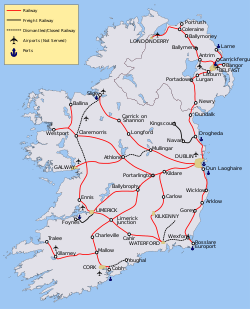Rail transport in Ireland
Rail transport in Ireland (InterCity, commuter and freight) is provided by Iarnród Éireann in the Republic of Ireland and by Northern Ireland Railways in Northern Ireland.
| Ireland | |||||||
|---|---|---|---|---|---|---|---|
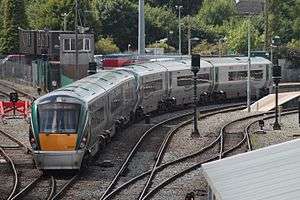 An Iarnród Éireann 22000 Class DMU at Drogheda MacBride station | |||||||
| Operation | |||||||
| Major operators | Iarnród Éireann & NIR | ||||||
| Statistics | |||||||
| Ridership | 47.9 million (Republic of Ireland, 2018)[1] 15 million (Northern Ireland, 2017)[2] | ||||||
| System length | |||||||
| Total | 2,733 km (1,698 mi) | ||||||
| Electrified | 53 km (33 mi) | ||||||
| Freight only | 362 km (225 mi) | ||||||
| Track gauge | |||||||
| Main | 1,600 mm (5 ft 3 in) | ||||||
| Electrification | |||||||
| 1500 V DC | DART in Dublin | ||||||
| Features | |||||||
| No. stations | 147 | ||||||
| |||||||
Most routes in the Republic radiate from Dublin. Northern Ireland has suburban routes from Belfast and two main InterCity lines, to Derry and cross-border to Dublin.
The accompanying map of the current railway network shows lines that are fully operational (in red), carrying freight only traffic (in black) and with dotted black lines those which have been "mothballed" (i.e. closed to traffic but potentially easy to re-open). Some airports are indicated but none are rail-connected, although Kerry Airport and Belfast City Airport are within walking distance of a railway station. Both the City of Derry Airport and Belfast International (Aldergrove) are near railway lines but not connected. Ports are marked, although few remain rail-connected. Larne Harbour, Belview Port and Rosslare Europort are ports that are still connected.
Ireland's only light rail service, named Luas, is in Dublin. No metro lines currently exist in Ireland, but there is a planned MetroLink line which would serve Dublin.
History
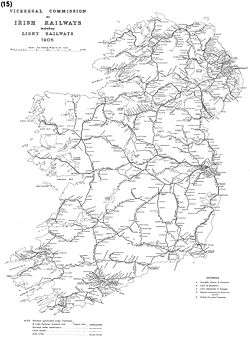
The first railway in Ireland opened in 1834. At its peak in 1920, Ireland had 5,600 km (3,480 mi) of railway, now only about one third of this remains. A large area around the border area has no rail service.
Ireland's first Light rail line was opened on Wednesday 30 June 2004.
Rolling stock
Locomotives
Diesel traction is the sole form of motive power in both the IÉ and NIR networks, apart from the electrified Howth/Malahide-Greystones (DART) suburban route in Dublin. Apart from prototypes and a small number of shunting locomotives, the first major dieselisation programme in CIÉ commenced in the early 1950s with orders for 94 locomotives of two sizes (A and C classes) from Metropolitan-Vickers which were delivered from 1955, with a further twelve (B class) locomotives from Sulzer in the late 1950s. Following poor reliability experience with the first generation diesel locomotives, in the 1960s a second dieselisation programme was undertaken with the introduction of sixty-four locomotives in three classes (121, 141 and 181) built by General Motors, of the United States. This programme, together with line closures, enabled CIÉ to re-eliminate steam traction in 1963, having previously done so on the CIÉ network prior to taking over its share of the Great Northern Railway. In parallel, NIR acquired three locomotives from Hunslet, of England, for Dublin-Belfast services. The Metropolitan-Vickers locomotives were re-engined by CIÉ in the early 1970s with General Motors engines.
The third generation of diesel traction in Ireland was the acquisition of eighteen locomotives from General Motors of 2475 h.p. output, designated the 071 class, in 1976. This marked a significant improvement in the traction power available to CIÉ and enabled the acceleration of express passenger services. NIR subsequently purchased three similar locomotives for Dublin-Belfast services, which was the first alignment of traction policies by CIÉ and NIR.
A fourth generation of diesels took the form of thirty-four locomotives, again from General Motors, which arrived in the early 1990s. This was a joint order by IÉ and NIR, with thirty-two locomotives for the former and two for the latter. They were again supplied by General Motors Electro-Motive Division. IÉ designated their locomotives the GM 201 class; numbered 201 to 234 (the NIR locomotives were later prefixed with an 8). These locomotives are the most powerful diesels to run in Ireland, and are of 3200 horsepower (2.5 MW), which enabled further acceleration of express services. The NIR locomotives, although shipped in NIR livery, were repainted in 'Enterprise' livery, as were six of the IÉ locomotives.
The 071 class are now used on freight services. NIR's three similar locomotives are numbered 111, 112 and 113. There is seldom more than one of these serviceable at a time.
Multiple units
NIR and IÉ both run suburban services using diesel multiple units (DMUs) – these are termed railcars in Ireland (see rail terminology).
Iarnród Éireann Railcars
| Class | Image | Type | Top speed | Number | Routes operated | Built | |
|---|---|---|---|---|---|---|---|
| mph | km/h | ||||||
| 2600 Class | 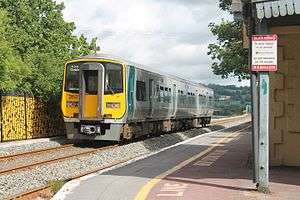 |
Diesel multiple unit |
70 | 110 | 8 | Mallow-Cork-Cóbh Mallow-Tralee (Sundays only) Cóbh-Midleton |
1993 |
| 2800 Class | 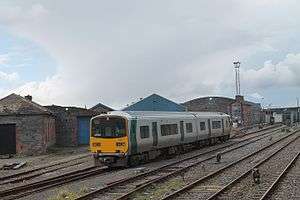 |
75 | 120 | 8 | Limerick-Waterford Limerick shuttle Limerick-Ennis Limerick-Galway Mallow-Tralee Ballina-Manulla Junction |
2000 | |
| 29000 Class | 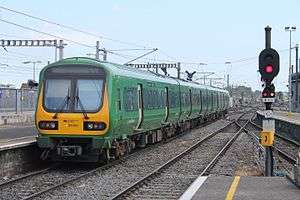 |
75 | 120 | 29 | Dublin-Maynooth Dublin-Drogheda/Dundalk Dublin-M3 Parkway Dublin-Maynooth/Longford Dublin-Rosslare Europort |
2002–2005 | |
| 22000 Class |  |
100 | 160 | 28 3-car 25 4-car 10 5-car sets |
Dublin Newbridge/Kildare/Port Laoise Dublin-Cork Dublin-Maynooth/M3 Parkway/Longford/Sligo Dublin-Rosslare/Galway/Westport Dublin-Dundalk Limerick shuttle Tralee shuttle |
2007–2012 | |
IÉ DMUs operate all InterCity services apart from Dublin to Cork and Dublin to Belfast (one service per week from Dublin Connolly to Belfast and back is Railcar).
Iarnród Éireann 22000 Class InterCity Railcars
There are 234 22000 Class carriages in total, being formed into the following sets:
- Ten 5-car sets – Each set includes a 1st Class Carriage and a Dining Carriage. They are used on key InterCity services between Dublin and Limerick, Galway, Waterford, Westport and Tralee.
- Twenty-five 4-car sets – These mostly operate on their own or with a 3-car unit. They serve lesser-used InterCity services and most Dublin to Sligo and Rosslare services.
- Twenty-eight 3-car sets – These mostly operate in pairs. They serve lesser-used InterCity services and many Dublin Commuter services.
Features of the InterCity Railcar fleet include:
- Automatic PA and information display systems
- Electronic seat reservation displays for web bookings
- Fully air-conditioned
- Internal CCTV system
- Sleek carriage design
- Advanced safety features throughout
Iarnród Éireann Commuter Railcars
IÉ introduced 17 new suburban railcars in 1994 as the 2600 Class (built by Tokyu Car, Japan) for the Kildare 'Arrow' suburban service. Further additions to the fleet were made in 1997 (twenty-seven 2700 Class, Alstom built, now withdrawn), 2000 (twenty 2800 Class, Tokyu Car built) and 2003 (eighty 29000 class, CAF built). When the 29000 Class was introduced all Irish railcars were re-branded from 'Arrow' to 'Commuter'. A further nine 4-car 29000 Class trainsets arrived in 2005.
NIR Railcars
NIR replaced their ageing DMUs with Class 3000 and Class 4000 regional railcars built by CAF, which arrived in 2005 and 2011, respectively.
Coaching stock
Mark 4 carriages
Iarnród Éireann's flagship InterCity fleet are the Mark 4.

Built by CAF of Spain in 2004–2005 they are formed into 8-car push-pull sets. Each set contains (in order):
- GM 201 class locomotive
- 5 Standard class carriages
- 1 restaurant carriage
- 1 'Citygold' (first class) carriage
- Generator Control Car
The Mark 4 trains have blue tinted windows, which help to create a cool journey for the passenger, electronic route maps showing train progress, electronic seat reservation displays and power points for laptops, or recharging tablets, MP3 players or mobile phones. Citygold customers on this fleet have the added features of adjustable seating, greater room and comfort and in-seat audio entertainment. They are used exclusively on the Dublin to Cork route; operating an hourly service each way.
The Mark 4 trains are capable of speeds of up to 125 mph (201 km/h), but are limited by the maximum line speed of 100 mph (160 km/h) and the locomotive.
Enterprise services
The Dublin to Belfast 'Enterprise' service is operated jointly by IÉ & NIR with rolling stock from De Dietrich, commissioned in 1997. Four Mark 3 Generator vans were introduced in September 2012. Until then, 201 Class locomotives were required to supply head-end power (HEP) for heating and lighting.
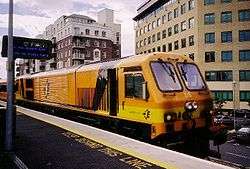
Previous stock
NIR also had a number of refurbished Class 488 carriages acquired from the Gatwick Express service and converted to run on the Irish 1,600 mm (5 ft 3 in) gauge. These were generally referred to as 'the Gatwicks'. They were in use from 2001 until June 2009.
Passenger services
Below is a list of all passenger routes on the island of Ireland. Please note following when examining routes
1. Services below usually, but not necessarily always, involve a change of trains. Changing points are shown in bold type.
2. Services at different times of day will serve a different subset of the stations shown below. The "stations served" lists all possible stops for any train on a given route. As an example, some services to Limerick do not involve a change at Limerick Junction, and some services to Cork may stop at Limerick Junction, Charleville and Mallow only.
Republic of Ireland InterCity routes
Dublin to Cork
- Stations served – Dublin Heuston, Portarlington, Port Laoise, Ballybrophy, Templemore, Thurles, Limerick Junction, Charleville, Mallow, Cork Kent
This was known as the 'Premier Line' of the Great Southern and Western Railway (GS&WR), being one of the longest routes in the country (266 km or 165 miles), built to a high standard and connecting to Galway, Limerick, Waterford and Kerry as well as to Cork. These other destinations all have their own services, although connections are offered to/from the Cork service at Limerick Junction (for Limerick) and Mallow (for Kerry). As of 2019 the line is receiving a major upgrade focusing this year between Newbridge and Ballybrophy. There are possessions of most sections of the line every night to carry out relaying. There are also disruptions and cancellations on most weekends. All relaying is using a much heavier rail to give a much smoother ride on trains. The new track at 60 kg, is the same that is used on the TGV in France. As the upgrading continues there are speed restrictions which are affecting punctuality of trains. A new platform is under construction at Limerick Junction on the down line which will reduce conflicts and reduce journey times by 3–5 minutes. A fourth track is planned between Park West-Cherry Orchard and Heuston which is also intended to further reduce journey times. As of 2019, 13 out of 29 services on the route daily are delivered in 2 hours 30 mins or under. 11 trains operate the service in between 2 hours 30 mins and 2 hours 35 mins, with all services 2 hours 40 mins or less. An early morning express service from Cork to Dublin makes the non-stop journey in 2 hours 15 mins.[3]
Dublin to Limerick
Stations served – Dublin Heuston, Sallins and Naas, Newbridge, Kildare, Monasterevin, Portarlington, Port Laoise, Ballybrophy, Templemore, Thurles, Limerick Junction, Limerick Colbert
This service follows the Cork route as far as Limerick Junction. Limerick services leave the main line via a direct curve built in 1967, onto part of the former Waterford and Limerick Railway (W&LR). The former two hourly timetable operated by 22000 Class railcars was cut back in November 2009 when the number of direct trains was reduced to three from Dublin to Limerick and four from Limerick to Dublin. On Sunday there are 6 trains in each direction. The remaining Dublin-Limerick-Ennis services involve a change at 'Limerick Junction' from a Dublin-Cork or Dublin-Tralee service onto a local train for the remaining 30 minutes of the journey.
Dublin to Galway
- Stations served – Dublin Heuston, Sallins and Naas (peak times only), Newbridge, Kildare, Monasterevin, Portarlington, Tullamore, Clara, Athlone, Ballinasloe, Woodlawn, Attymon, Athenry, Oranmore and Galway Ceannt.
The present route, built by the GS&WR in competition with the MGWR, leaves the Cork main line just after Portarlington. The River Shannon is crossed at Athlone. Athenry, the second last station before Galway, became a junction once again in 2010 with the reopening of the line to Limerick and would do so again if the planned reopening of the line to Tuam proceeds in accordance with Transport 21. In February 2011 planning permission was obtained for a station at Oranmore and opened 28 July 2013. All services are operated by 22000 Class railcars.
As of 2019, journey times range between 2 hours 11 minutes to 2 hours 37 minutes. 8 services operate in 2 hours 20 mins or less Monday to Friday. There are 9 direct trains in each direction Monday-Thursday. On Friday the 07:35 express Heuston goes to Westport instead of Galway but there is a connecting train to Galway from Athlone. For the college term there is an extra service from Galway to Dublin at 15:35
Dublin to Tralee
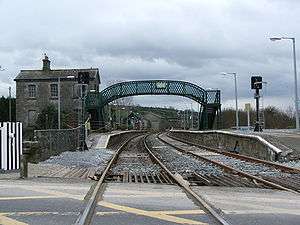
- Stations served – Dublin Heuston, Portarlington, Port Laoise, Thurles, Limerick Junction, Charleville, Mallow, Banteer, Millstreet, Rathmore, Killarney, Farranfore, Tralee Casement
This relatively indirect route runs along what is in essence a branch line connected to the Cork–Dublin mainline at Mallow. Trains run to/from the south of Tralee. As of 2017 there were eight trains from Mallow to Tralee and nine trains the other way around. All services are operated by 22000 Class railcars, with the exception of the very early morning service from Tralee to Cork and some Sunday services (From Tralee to Cork via Mallow) which are operated by a 2-carriage 2600 Class Commuter set. There is 1 service a day from Dublin Heuston to Tralee in each direction Monday to Friday. On Sunday there is two trains from Heuston to Tralee and three from Tralee to Heuston. Journey times range from 3 hours 40 minutes to 3 hours 53 minutes. On this line Farranfore railway station provides a direct connection with Kerry Airport.
Dublin to Waterford
- Stations served – Dublin Heuston, Hazelhatch and Celbridge, Sallins and Naas, Newbridge, Kildare, Athy, Carlow, Muine Bheag, Kilkenny MacDonagh, Thomastown, Waterford Plunkett.
Since Kilkenny is a stub station, reversal is necessary. Non Passenger trains such as the DFDS Freight train from Ballina to Waterford avoid Kilkenny by using Lavistown loop which joins both lines going into Kilkenny. Some passenger trains use the loop to reducing the journey time.
Dublin to Westport/Ballina
- Stations served – Dublin Heuston, Newbridge, Kildare, Monasterevin, Portarlington, Tullamore, Clara, Athlone, Roscommon, Castlerea, Ballyhaunis, Claremorris, Manulla Junction, (Foxford, Ballina) or (Castlebar, Westport).
The line is served primarily by a 22000 Class DMU on Dublin – Westport. On the Manulla Junction – Ballina section a 2800 Class diesel railcar operates. There are 3 services a day from Heuston to Westport and 5 From Westport to Heuston Monday to Thursday and on Friday the 07:35 Heuston to Galway goes to Westport and the 09:08 Athlone to Westport goes to Galway and then the 17:10 Heuston to Athlone is extended to Westport and there is 5 trains from Westport to Heuston. There is also 1 service daily from Athlone to Westport Monday to Thursday. Journey times range from 3 hours 6 minutes to 3-hour 44 minutes.
Dublin to Gorey/Rosslare Europort
- Stations served – Dublin Connolly, Tara Street, Dublin Pearse, Dún Laoghaire Mallin, Bray Daly, Greystones, Kilcoole (limited service), Wicklow, Rathdrum, Arklow, Gorey, Enniscorthy, Wexford O'Hanrahan, Rosslare Strand, Rosslare Europort.
There are four end to end journeys in each direction Mondays to Fridays inclusive, the first of which from Rosslare Europort extends beyond Dublin to Dundalk. An early morning Gorey to Connolly commuter service which, on its evening return, extends to Wexford also operates. On Saturdays and Sundays there are three end to end journeys each way plus a Gorey to Dundalk Commuter service. The 16:37 Dublin Connolly to Rosslare Europort Mondays to Fridays journey offers connectional opportunities into ships to Wales and France. Some peak services also stop at Lansdowne Road station as well and some services skip Kilcoole. This service has the slowest average speed at roughly 53 kilometres per hour. Services are either ICR's of 29000 commuter trains.
A resignalling project in Dublin increases the ability of Iarnród Éireann to run 12 to 20 trains per hour in both directions through the Howth Junction to Grand Canal Dock line, which caters for Howth DARTs, Malahide DARTs, Northern Commuter trains, Belfast Enterprise services, Sligo InterCity and Maynooth Commuter services, as well as other services in the Connolly to Grand Canal Dock area.[4]
Dublin to Sligo
- Stations served – Dublin Connolly, Drumcondra (peak times only), Maynooth, Kilcock, Enfield, Mullingar, Edgeworthstown, Longford, Dromod, Carrick-on-Shannon, Boyle, Ballymote, Collooney, Sligo Mac Diarmada.
All services are operated by 22000 Class railcars with a service every 2 hours until 7 pm. The first Sunday service from Dublin is operated by 29000 Class railcars. This returns from Sligo at 6 pm. Only peak services call at Drumcondra
Cork to Tralee
- Stations served – Cork Kent, Mallow, Banteer, Millstreet, Rathmore, Killarney, Farranfore, Tralee Casement
This is a three times daily service with two trains departing in the morning and one in the evening. The service is run by a 22000 Class.
Farranfore railway station connects with Kerry Airport.
Limerick to Waterford
- Stations served – Limerick Colbert, Limerick Junction, Tipperary, Cahir, Clonmel, Carrick-on-Suir and Waterford Plunkett.
The Limerick–Waterford route is the only true non-radial (from Dublin) route still open in Ireland that is not a branch line. The route was commenced in 1848 by the Waterford & Limerick Railway and completed in 1854.
Timetabling, as of 2019, requires passengers to change at Limerick Junction. There are two services per day, each way, with no service on Sundays or Public Holidays. Timetabled journey times vary between 2hrs35mins & 2hrs43mins.
Limerick–Ennis–Galway
- Stations served – Limerick Colbert, Sixmilebridge, Ennis, Gort, Ardrahan, Craughwell, Athenry, Oranmore and Galway Ceannt.
This service started 30 March 2010 with the reopening of the Ennis–Athenry line. Direct trains now travel from Limerick to Galway with the Ennis commuter services have been subsumed into these.
All of the new stations are unstaffed. Gort has two platforms with lifts, bridges, ticket machines and a loop while Sixmilebridge, Ardrahan and Craughwell have just one platform each. In Gort the signal cabin has been restored and relocated and there is a small depot for permanent way crew. This reopening was the Phase One of the reopening of the Western Rail Corridor. It involved the relaying of 58 km of track, rebuilding bridges, installation of signalling systems, level crossing upgrades and building the stations. The journey time between Limerick and Galway is just under 2 hours and there are 5 trains each way daily.
The line has seen some growth, with the Irish Times reporting that from 2013 to 2014, "the western rail corridor saw a 72.5 per cent increase from 29,000 to 50,000 journeys through the Ennis- Athenry section of the line.", which was partly attributed to the introduction of online booking and promotional fares.[5]
Republic of Ireland commuter routes
Dublin Suburban Rail
- Dublin Area Rapid Transit (DART) – Greystones to Howth/Malahide.
- Northern Commuter – Dublin Pearse to Dundalk
- South Eastern Commuter – Dublin Connolly to Gorey.
- South Western Commuter – Dublin Heuston/Grand Canal Dock to Port Laoise/Newbridge.
- Western Commuter – Dublin Pearse/Docklands to Maynooth/M3 Parkway/Longford.
Mallow to Cork
Cóbh to Cork
Midleton to Cork
Galway to Athenry
Limerick to Ennis
- Stations served – Limerick Colbert, Sixmilebridge, Ennis
Limerick to Nenagh and Ballybrophy
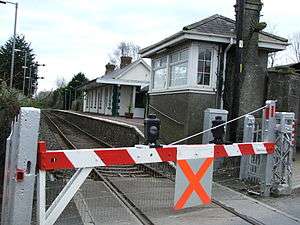
- Stations served – Limerick Colbert, Castleconnell, Birdhill, Nenagh, Cloughjordan, Roscrea, Ballybrophy
The line branches from the Waterford line just outside Limerick at Killonan Junction. All trains on this line connect with Dublin trains at Ballybrophy.
Current services on the line consist of two return passenger trains a day from Limerick. Following a campaign by The Nenagh Rail Partnership founded by local politicians and community representatives and assisted by the Internet news group Irish Railway News, a market research survey was funded by local Government. The market research was carried out in the summer of 2005 and showed there existed a market for improved services on the line. As a result of this study IÉ has committed to allocating additional rolling stock to the line as part of its ongoing fleet replacement programme. This line is subject to many speed restrictions due to the need to replace several old sections of track.
In October 2007, following a meeting between Iarnród Éireann management and The Nenagh Rail Partnership, it was confirmed that the new commuter service would be introduced between Nenagh and Limerick on Monday 1 September 2008. This was launched as planned on Monday 1 September 2008.
Closure of Ballybrophy–Roscrea–Nenagh–Limerick line proposed
A news report in January 2012 suggested that Iarnród Éireann might seek permission from the National Transport Authority to close the line,[6] but in February 2012 an enhanced timetable for the line was published, indicating that a decision to close has been deferred pending the outcome of the service upgrade.[7]
Waterford to Rosslare (closed)
Stations Served – Waterford Plunkett, Campile, Ballycullane, Wellingtonbridge, Bridgetown, Rosslare Strand, Rosslare Europort.
There was a single service each way on the Waterford-Rosslare stretch, operated by 2700 Class railcars taking just over 1 hour. The original purpose of the service, providing a railway link to the cities of Waterford, Limerick (and Cork via Limerick Junction) was compromised in the end by poor connections to other services from Waterford.
The service closed for passenger services on Saturday 18 September 2010. Replacement transport consists of a revised schedule and routings on the existing Bus Éireann route 370.[8] Buses on the route are branded "370 Connect", to Waterford Bus Station which is a 5-minute walk from Waterford Railway Station.
The line is still open for stock transfers. 22000 Class and 29000 Class DMUs operated on the line on Saturday 5 November 2011.
Northern Ireland routes
Services in Northern Ireland are sparse in comparison to the Republic or other countries. A large railway network was severely curtailed in the 1950s and 1960s (in particular by the Ulster Transport Authority). Routes now include suburban services to Larne, Newry and Bangor, as well as services to Derry. There is also a branch from Coleraine to Portrush. On Northern Ireland Railways distances are quoted in miles and metres.[9]
Belfast suburban
Three suburban routes run on 20-minute frequencies in and out of Belfast Great Victoria Street railway station, these routes then pass through Belfast Central railway station before continuing onto destinations at Bangor, Derry, Larne and Newry.
Belfast to Derry
- Stations served: Great Victoria Street, City Hospital, Botanic, Belfast Central, Yorkgate (partial service), Whiteabbey (partial service), Mossley West, Antrim, Ballymena, Cullybackey, Ballymoney, Coleraine, Castlerock, Bellarena, Derry.
The service to Derry has suffered from a lack of funding over recent decades. The existing line is not continuously welded and has speed restrictions in parts. For some time the threat of closure hung over this route but a funding package of £20 million was confirmed in December 2005. The same month saw the introduction of the new CAF railcars on the line and despite the fact that the service remained slower than the Derry-Belfast Ulsterbus service, the improvements saw a rise in passenger numbers to over 1 million per annum. However, these in 2007 when it was revealed that the £20 million earmarked had not been spent while there had been a £20 million overspend on the Belfast-Bangor line.[10] While the "Into the West"[11] rail lobby group had proposed extending the line cross border into County Donegal to Letterkenny and then on to Sligo thus releasing EU funding[12] Currently, the Department has partly completed a plan in place for Regional Development, for relaying of the track between Derry and Coleraine by 2013, which includes a passing loop, and the introduction of two new train sets. The £86 million plan is expected to reduce the journey time between Belfast and Derry by 30 minutes and allow commuter trains to arrive in Derry before 0900 for the first time.
Coleraine to Portrush
Stations served: Coleraine, University of Ulster, Dhu Varren, Portrush.
Belfast to Larne Harbour
Stations – Belfast Great Victoria Street, City Hospital, Botanic, Belfast Central, Yorkgate, Whiteabbey, Jordanstown, Greenisland, Trooperslane, Clipperstown, Carrickfergus, Downshire, Whitehead, Ballycarry, Magheramorne, Glynn, Larne Town, Larne Harbour.
Cross-border routes
Belfast–Dublin and Dublin–Belfast
- Stations served – Belfast Central, Lisburn, Portadown, Newry, Dundalk Clarke, Drogheda MacBride, Dublin Connolly
This cross border service, named Enterprise, is jointly owned and run by Northern Ireland Railways and IÉ. Despite having some of the most modern InterCity rolling stock on the island, it has been dogged by numerous problems. An historical problem on this route has been disruption to services caused by security alerts (devices on the line, hoax devices, threats and warnings). These continue to the present day.
The punctuality on this service remains poor for other reasons. The InterCity route, despite being mostly high quality continuous welded rail, is shared with suburban services outside both Belfast and Dublin.
A further problem was due to the locomotive and rolling stock arrangements. Unlike most other locomotive-hauled rolling stock in Ireland, generator vans were not part of the train – even the DVTs did not supply power. Thus the General Motors-built locomotives had to supply head-end power for lighting and heating throughout the train. Although many types of locomotive are well designed for this purpose, these particular locomotives had struggled under the extra strain. The wear on the locomotives and time out of service were unusually high. On at least two occasions locomotives had burst into flames while shuttling along the route. To avoid further damage, four Mark 3 Generator Vans entered service in September 2012.
The collapse of the Malahide Viaduct in late 2009 temporarily stopped all Enterprise services from Dublin to Belfast for 3 months.[13] The viaduct was repaired and the line re-opened in November 2009.[14]
Freight
The following freight services operate in Ireland :
- DFDS charter freight trains for Intermodal containers from Ballina – Waterford Port (Belview)
- Timber trains from Ballina to Waterford Port (Belview)
- Timber trains from Westport to Waterford Port (Belview)
- Zinc ore from Tara Mines, Navan – Dublin Port (North Wall)
- International Warehousing and Transport chartered Liner from Ballina – Dublin Port (North Wall) (Started September 2009)
Rail freight has been in a major decline in Ireland for the past 10 years.
- IÉ closed its container rail freight business on 29 July 2005, saying that the sector had accounted for 10% of its freight business, but 70% of its losses.
- Container freight levels had dropped to c.35 containers on three trains per day.[15] Yet Iarnród Éireann estimated that a minimum of 18 40-foot containers was needed for a commercially viable trainload. The impact of this will be about 40 more lorries a day, described by Iarnród Éireann as a 'drop in the ocean' when compared to the 10,000 lorries entering Dublin Port every day. Nevertheless, the annual impact of this will shift about 70 million tonne-kilometres to the road network.
- In July 2006, the Container Gantries at Mallow and Sligo were removed, Limerick's Gantry yard is now a car park and the bulk of Cork's freight yard is primed for development.
Freight services which no longer run included:
- Ammonia trains from Shelton Abbey, Wicklow–Cork (due to closure of fertiliser plant)
- Bagged Cement Nationwide
- Beer Kegs Nationwide
- Bell Liner Mayo–Waterford
- Gypsum Kingscourt–Dublin
- Bulk Cement from Platin (near Drogheda) and Castlemungret (near Limerick) cement factories to cement silos at Sligo Quay, Athenry, Cabra (Dublin), Cork, Waterford, Tullamore and Belfast
Other losses included services carrying fertilisers, grain, tar, scrap metal, molasses and coal. The last bulk cement flow to operate in Ireland (Castlemungret – Waterford) ended in December 2009 along with the Kilmastulla Quarry – Castlemungret Shale traffic, despite making profits in the region of €1.3 million in 2006.
Remaining freight traffic is supported by an agreement with Coillte to increase timber trains from Ballina to Belview from three to four weekly. This may reflect the failure of the railway to dispose of its surplus Class 201 locomotives made surplus by the retirement of the Mark 3 coach fleet.
Bord na Móna operates an extensive 1,930 km (1,199 mi) narrow-gauge railway. This is one of the largest industrial rail networks in Europe and is completely separate from Ireland's passenger rail system operated by Iarnród Éireann. It is used to transport peat from harvesting plots to processing plants and power stations of the Electricity Supply Board.
Heritage railways
Ireland has a small but thriving heritage railway scene. Several groups exist, mostly small affairs ran by individuals, though several larger groups exist. There are a couple of railtour-operating groups, one 5 ft 3 in (1,600 mm) self-contained railway, and a large number of 3 ft (914 mm) museums.
Established groups
- The Railway Preservation Society of Ireland based in Whitehead, County Antrim runs preserved steam trains on the main lines all over Ireland.
- The Downpatrick & County Down Railway is the only self-contained full-size heritage railway in Ireland, running trains along its 4 miles of track in addition to its capacity as a static museum.
- The Irish Traction Group preserves diesel locomotives but does not have a private line of its own. Instead, four of its locomotives are based at Carrick-on-Suir, four at Moyasta, and five at the DCDR.
- The Ulster Folk and Transport Museum contains various railway and tramway vehicles of numerous gauges from all across Ireland.
- The Irish Railway Record Society has a library of Irish railway documents at Heuston station and charters an annual railtour.
- The Modern Railway Society of Ireland, which promotes interest in modern-day Irish Railways and charters occasional railtours.
- The Stradbally Woodland Railway, ran by the Irish Steam Preservation Society.
- The Giant's Causeway and Bushmills Railway, a recreation of the original Giant's Causeway Tramway. Steam running ceased at the railway in 2012 with the arrival of a new-build tram.
- The Peatlands Park Railway, which formerly ran peat trains but now instead carries passengers.
- The National Transport Museum of Ireland has several tramway vehicles.
- The Cavan and Leitrim Railway has 0.4 km of 3 ft gauge track and a small transport museum, located next door to Iarnród Éireann's Dromod railway station.
- The Donegal Railway Heritage Centre, a museum dedicated to the County Donegal Railways Joint Committee housed in the former Donegal railway station.
- The Fintown Railway, which runs a former CDRJC railbus along the shore of Lough Finn.
- The Lartigue Monorail in Listowel, an accurate demonstration of Ireland's only monorail system.
- The West Clare Railway, with a collection of 5 ft 3 in and 3 ft stock based in the restored Moyasta Junction railway station.
- The Waterford and Suir Valley Railway, which runs 10 km of 3 ft gauge line between Kilmeadan and Waterford.
- The Lullymore Heritage Railway, a former peat railway on a mineral island in County Kildare.
- The Dundalk Railway Heritage Society, which organises events pertaining to Dundalk's railway history.
- Dundalk Railway Station has a small museum incorporated in the waiting room.
- Cork Railway Station is home to No. 36, the oldest surviving steam locomotive in Ireland.
Private efforts
- Headhunter's Barbershop & Railway Museum, in Enniskillen, which is home to a large collection of Great Northern, Sligo and Leitrim, and Clogher Valley memorabilia.
- The Arigna Mining Experience has two 3 ft gauge carriages.
- The Difflin Lake Railway, a 15 inch gauge railway near Raphoe, County Donegal.
- The Clonakilty Model Village, which has a Ruston diesel and two Park Royal carriages.
- Belturbet Railway Station, which is fully restored and has several items of rolling stock.
- Dunsandle Railway Station, which is fully restored and has several items of rolling stock.
- Farrangalway Railway Station, home to an unrestored Waterford, Limerick and Western Railway six-wheeled carriage.
- Kiltimagh Railway Station, which has two restored carriages.
- Clifden Railway Station, fully restored and home to a Midland Great Western Railway six-wheeled carriage.
- Halfway Vintage Club, which has a brake van, beet wagon and Ruston diesel shunter.
- Quirky Nights Glamping Village has a British Rail Class 421, which will be converted to accommodation.
- Guinness Brewery has a few examples of stock from its former narrow gauge system on display.
- Wolfetone Square in Dublin utilises a former Lisbon Tram as a restaurant.
- The Glenlo Abbey Hotel, near Galway, uses three grounded railway carriages as its restaurant.
- The Killashee House Hotel, near Naas, has two grounded carriages in an unrestored condition.
- The Curragh Nurseries, near Naas, uses a grounded Mark 3 carriage as a restaurant.
- Sligo Folk Park has a grounded carriage.
- Dunfanaghy Glamping has a CDRJC carriage in use as holiday accommodation.
Many more examples of grounded carriages and wagons can be found across the country on private residences, usually in use as sheds or accommodation.
In addition, many examples of Irish rolling stock survives in museums in England, Wales, and the US.
Former heritage railways
- The Foyle Valley Railway in Derry, which closed in 2015.
- The Tralee and Blennerville Railway, which closed in 2006.
- The Clonmacnoise and West Offaly Railway, which closed in 2008.
- The Shane's Castle Railway, which ran from 1971 to 1995.
- The Great Southern Railway Preservation Society, which attempted to set up a preserved line between Tralee and Fenit, but fell through in the early 1990s.
- Westrail, which ran steam and diesel trains between Claremorris, Tuam, Athenry and Galway until 1993.
- Riverstown Old Corn Mill, on the Cooley Peninsula, which has several 4 ft 8 1⁄2 in (1,435 mm) gauge vehicles. It has been closed for several years.
Future
Routes
Western Rail Corridor
The first stage of the reopening of the Western Rail Corridor, between Ennis and Athenry, was completed in 2009. As of 2020, the remaining stages, from Athenry to Tuam, Claremorris and Collooney, are not planned to be reopened.
Heavy rail to Navan
Iarnród Éireann had proposed extending existing commuter services to M3 Parkway railway station to Navan via Dunshaughlin and Kilmessan.[16] However, as of late 2019, this proposal was deferred subject to "review".[17]
DART and DART Underground
A proposed tunnel, connecting Heuston Station and Pearse Station and onwards to the Northern Commuter line, referred to as the DART Underground, is not planned to be operational until sometime "after 2030".[18] This proposal included electrification to Balbriggan, Maynooth and Hazelhatch.
As of 2019, the tunnel sections of DART Undgeround remain suspended,[19] though work has begun on delivering overground extension to Maynooth, M3 Parkway, Drogheda, Docklands and Hazelhatch; with the Maynooth line and M3 Parkway branch scheduled first.
Foynes Port
The Shannon Foynes Port Company has been seeking reinstatement of the Limerick to Foynes Railway Line, which last operated in 2000,[20] as part of their expansion plans. The company have commissioned a design for reinstatement by Irish Rail,[21] however no funding is in place as of 2020.[22]
Dublin Metro
MetroLink is proposed to run from Estuary on Dublin's northside to Beechwood via Dublin Airport and St. Stephen's Green. Its route proposes mainly elevated tracks in the Swords area, with a tunnel running from north of Dublin Airport to Charlemont. As of 2018, construction on the line was scheduled to begin in 2021, with the line proposed to open in 2027.[23]
Luas
There has been, at various points, plans or proposals to extend Luas to Swords, Dublin Airport, Lucan, Bray, and Old Fassaroe.
There have also been proposals to create a Luas system in Cork City. These first date from when the Fianna Fáil government first considered the proposal in 2007 at the urging of coalition partners, the Green Party. They were abandoned after the recession began later in the year. Plans were revisited by the Cork City Council in 2017, and were also considered once more as part of the Fine Gael government's Ireland 2040 proposals.
Northern Ireland Railways
The potential to reopen a number of railway lines in Northern Ireland has included speculation on such lines as the line between Antrim and Castledawson.[24][25]
The reopening of the third line between Great Victoria Street and Adelaide may be tied into the future Belfast Transport Hub.
Downpatrick and Co. Down Railway
Subject to land acquisition and funding, the Downpatrick and County Down Railway has plans to extend its network to Ballydugan, Downpatrick Racecourse, and the Saint Patrick's Centre.
West Clare Railway
Following the granting of planning permission, the West Clare Railway is to build a new museum to house its own collection and that of the Irish Traction Group, as well as an eventual 6 km of dual gauge (5 ft 3 in and 3 in) track from Moyasta to Kilrush.
HSL Ireland
In July 2020, during a North/South Ministerial Council meeting, it was proposed to undertake a feasibility study on a possible high-speed line between Belfast-Dublin-Cork.[26] The deputy First Minister, Michelle O'Neill, said on Twitter that she would favour extending such a line to Derry.[27]
Stations
New stations
Calls to open or reopen stations on existing lines have included proposals for Kishoge, which is structurally complete but yet to be opened, and Lisburn West, which is under construction. Monard, Dunkettle, and Kilbarry on the Cork Suburban network were cancelled due to the Post-2008 Irish economic downturn.
In February 2018 the Irish Independent reported the National Transport Authority favoured building four new DART stations along the line to Heuston, including Cabra, Glasnevin, the Docklands and Woodbrook.[28]
Refurbished stations
Translink are currently building new transport hubs in both Belfast and Derry. The Belfast Transport Hub will have eight platforms, and allow the existing Great Victoria Street station to close. The Enterprise will move here from Belfast Central. The Derry Hub, meanwhile, will be inside the historic Belfast and Northern Counties Railway station, the original terminus of the line.
Plans also exist for station refurbishments at Lurgan, Adelaide, Yorkgate, Ballymena and Portrush. A refurbishment of Belfast Central was undertaken, with the station renamed ''Lanyon Place'' in September 2018.
Rolling stock
In 2017, increasing demand led Iarnród Éireann to issue tenders for the refurbishment of 10 2700 class sets, which had been held in storage for 6 years with the intention of planned use around Limerick from early 2019. The displaced trains are intended for use in the Greater Dublin Area.[29]
As of early 2018, Iarnród Éireann proposed to place an order for new DART stock capable of running off diesel or electric.[30]
As of 2018, NI Railways had plans to invest in a third wave of new trains to meet growing demand.[31]
As of 2018, a campaign was underway to preserve four 80 Class vehicles at the Downpatrick and County Down Railway, with hopes of bringing them to the heritage railway by the end of 2018.[32] Also in 2018, one of the two Cavan and Leitrim Railway steam locomotives, No. 3 ''Lady Edith'', was proposed to be repatriated by the West Clare Railway (from the New Jersey Museum of Transportation).[33]
See also
- Heritage railways in Northern Ireland
- Heritage railways in the Republic of Ireland
- Irish Sea Tunnel
- Rail Users Ireland
- Rail gauge in Ireland
References
- "Irish Rail losses up slightly despite record passenger numbers". Irish Times. 23 July 2019. Retrieved 10 August 2019.
- "40% increase in rail passengers on Derry line". Derry Journal. 25 September 2018. Retrieved 25 April 2019.
- "New Rail Timetable for 2013– Iarnród Éireann". Irishrail.ie. 15 January 2013.
- "Investment in Iarnród Éireann". irishrail.ie. 31 January 2015. Archived from the original on 17 December 2014. Retrieved 2 April 2015.
- O'Brien, Tim. "Iarnród Éireann passenger numbers up by 1 million". The Irish Times.
- Seán McCárthaigh (2 January 2012). "Iarnród Éireann may close rail service amid falling demand". Examiner.ie. Retrieved 24 August 2012.
- "Nenagh, Limerick and Commuter service improvements – REVISED SCHEDULE, FROM 20TH MARCH – Iarnród Éireann". Irishrail.ie. 16 March 2012. Archived from the original on 12 November 2013. Retrieved 24 August 2012.
- "Archived copy" (PDF). Archived from the original (PDF) on 20 December 2011. Retrieved 23 April 2011.CS1 maint: archived copy as title (link)
- http://www.raib.gov.uk/cms_resources/070718_R252007_Trooperslane.pdf
- "Belfast-Bangor line". BBC News. 22 March 2007. Retrieved 24 August 2012.
- "Into the West". Intothewestrail.com. Retrieved 24 August 2012.
- "S . E . A . - Rail group seek EU funding for NW rail network". 9 August 2007. Archived from the original on 9 August 2007.
- "Bridge on Dublin-Belfast Line Collapses". Raidió Teilifís Éireann. 21 August 2009. Retrieved 24 August 2012.
- "Dublin-Belfast Rail ReOpens". Raidió Teilifís Éireann. Retrieved 24 August 2012.
- "Historical debates". Historical-debates.oireachtas.ie. Archived from the original on 4 February 2012. Retrieved 24 August 2012.
- "Investment in Iarnród Éireann". Irish Rail. 31 January 2015.
- "Planning minister asks that Navan Rail line priority be downgraded". Meath Chronicle. 26 August 2019. Retrieved 10 October 2019.
- "'We won't let go': Irish Rail is convinced the long-delayed Dart Underground will go ahead". TheJournal. 21 September 2017.
- "Plans for Liffey bridge derailed by Dart Underground scheme". irishtimes.com. Irish Times. 4 January 2019. Retrieved 17 March 2019.
The 7.6km [..DART underground..] was shelved by the Fine Gael-Labour government in 2011 [and] was not included in the 10-year National Development Plan published [in 2018..] the timeframe for the [DART underground] review is unknown
- "Fears over closure of Foynes rail link are allayed". The Irish Times.
- Oireachtas, Houses of the (24 July 2018). "Rail Network Expansion – Tuesday, 24 Jul 2018 – Parliamentary Questions (32nd Dáil) – Houses of the Oireachtas". www.oireachtas.ie.
- "Pressure builds for Foynes Port Rail Link". 5 December 2019.
- Revealed: Preferred route for €3bn MetroLink from city centre to Dublin Airport unveiled. independent.ie (22 March 2018). Retrieved 30 March 2018.
- Barrow, Keith. "New lines proposed in Northern Ireland rail plan". Retrieved 8 April 2018.
- "New lines proposed in Northern Ireland rail plan". railjournal.com. 3 May 2014.
- Finn, Christina. "Irish and NI governments to examine the possibility of a high-speed Belfast-Dublin-Cork rail line". TheJournal.ie. Retrieved 1 August 2020.
- O'Neill, Michelle (31 July 2020). "How about a Derry - Belfast - Dublin - Cork high speed rail line! Now that would be a game changer!". Twitter. Retrieved 1 August 2020.
- "New Dart plan backs away from underground route". The Irish Independent. Retrieved 8 April 2018.
- "Iarnród Éireann to refurbish 28 carriages after six years out of service". Irish Examiner. 26 July 2018. Retrieved 9 September 2018.
- Barrow, Keith. "Irish Rail plans bi-mode train order for Dart expansion". Retrieved 8 April 2018.
- "NI Railways 50th Anniversary – Translink". translink.co.uk. Translink. Archived from the original on 9 April 2018. Retrieved 8 April 2018.
- "Save an 80 class! | Downpatrick & County Down Railway". www.downrail.co.uk. Retrieved 8 April 2018.
- "PressReader.com – Connecting People Through News". pressreader.com. Retrieved 8 April 2018.
External links
| Wikivoyage has a travel guide for Rail travel in Ireland. |
| Wikimedia Commons has media related to Rail transport in Ireland. |
- Website of Iarnrod Éireann (Irish Rail)
- Website of Northern Ireland Railways
- Railway Procurement Agency
- Platform For Change (Dublin Transportation Office)
- Strategic Rail Review 2003 (Department of Transport)
- Rail Users Ireland – Ireland's National Rail User organisation
- Eiretrains – Irish Railways Past & Present
